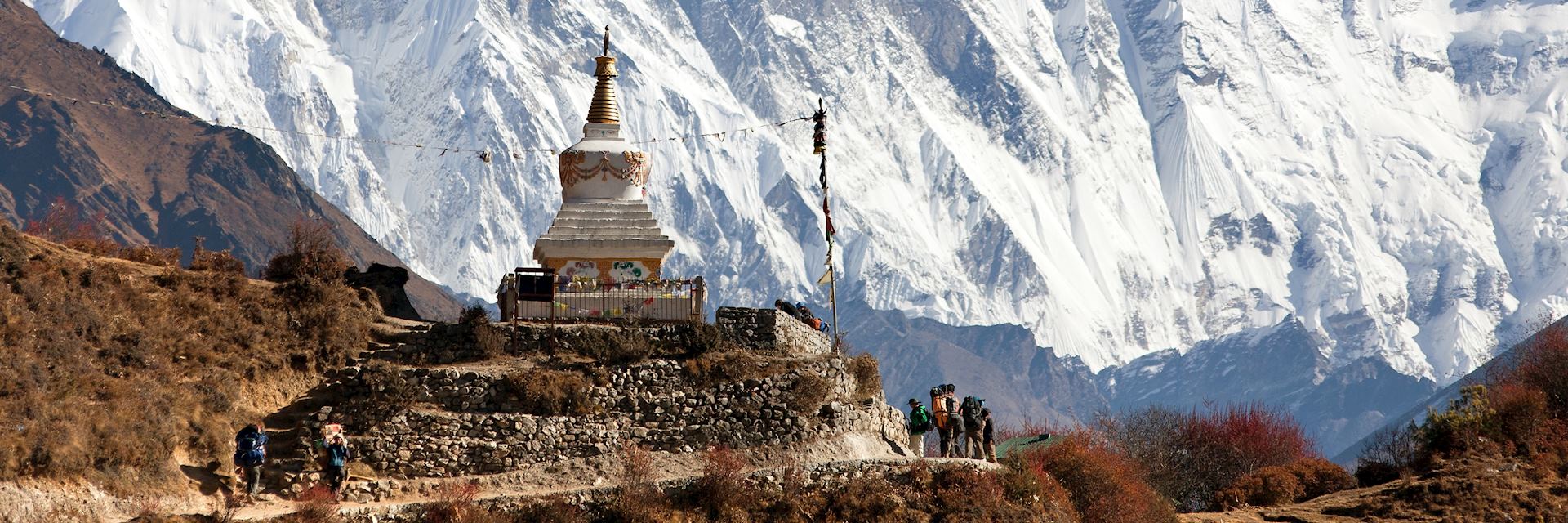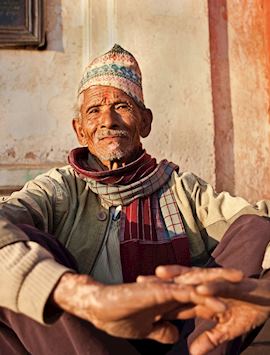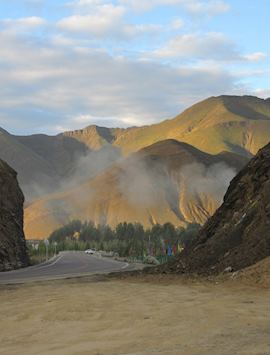By Audley Nepal specialist Andy
I first went to Nepal in 1987 after months journeying through India. Looking back through my old photographs, little has changed. The clothing is more Westernised and more vehicles are on the road, but Nepal has kept its dusty, chaotic atmosphere.
Only 20% of Nepal is accessible by road. If you want to see the rest of the country, you’ll need to trek. You’ll walk alongside local people, passing villages reachable only by foot. I first went trekking one soggy, cloudy May — it’s not recommended. I went away feeling like I’d missed something. Returning the following November, I was rewarded with the most impressive scenery I’d ever seen.
Exploring Kathmandu

Regardless of where you travel in Nepal, Kathmandu, with the only international airport, will be your starting point. If you’re planning a long trek, you’ll spend a few days here to attend a trek briefing, as well as to recover from your flight. I’d suggest making time to explore the city. The western Thamel district is full of curio shops, markets and restaurants, where you can enjoy some momos (traditional dumplings).
When I first stayed in Kathmandu in the 80s, I chose the centrally located Kathmandu Guest House. It’s still there, with a new wing and a carefully tended garden. If I ever get lost in Kathmandu — which I do all the time — I always seem to find my way back there. Each room is simple but clean, air-conditioned and brightened with traditional fabrics.
Where to go trekking in Nepal
Annapurna region

A subrange of the Himalaya, the Annapurna region lies northwest of Kathmandu. It benefits from being lesser known than the Everest region, with fewer walkers on the trails. I find the Annapurna offers more variety, with treks passing fertile foothills, farms and forest before reaching glaciers and mountains. Each valley shelters a community keen to welcome you, from Hundi farmers to Tibetan monks. Plus, you’ll still find peaks over 8,000 m (26,246 ft).
See the Annapurna range from Poon Hill

If you’re looking for something a little more challenging, and like having a target to aim for, I’d suggest trekking to Poon Hill. The five night trek starts from Pokhara and climbs up well-paved deep steps and through tree-lined valleys until you reach the summit of Poon Hill. At 3,200 m (10,498 ft), its modest name doesn’t quite do it justice. At the summit, the full Annapurna range is spread out in front of you like a geographic illustration — you can see every peak.
En route, you’ll spend the first few nights in luxurious lodges. Climbing higher, you’ll stay in tea lodges: traditional mountain inns. Its rooms are private and comfortable, but you’ll share a bathroom. Evenings are spent with your fellow guests around the fire, and I can recommend the local Yeti Beer.
Reaching Annapurna Base Camp

The real challenge of the Annapurna range is trekking to Annapurna Base Camp. The combination of the high altitude and steep tracks makes it one of the toughest treks I’ve undertaken, but I’ve never seen mountain scenery like it since. Every morning I awoke to a brilliant blue sky, flashes of sunlight reflecting off the snow.
The trek takes two weeks, starting from Pokhara and heading ever up from there. The first few days are surprisingly vibrant, as you pass busy hamlets, farmers tending to their rice fields and expanses of rhododendron bushes, covered with magenta flowers in late spring. Heading onward into thick bamboo forest, you might spot rare orchids and ferns.
On the sixth day, I hiked across a grassy pasture at Tomo to reach the Panchenin Barha Canyon, which acts as a natural gateway into the Annapurna Sanctuary. The Sanctuary is an isolated basin surrounded by a ring of Nepal’s highest peaks, creating a natural amphitheatre for Himalayan scenery. The canyon is the only way into the basin with a small trailside shrine marking the path into the sanctuary.
After a night in a tea lodge we made our final climb to Annapurna Base Camp at 4,100 m (13,451 ft). Along the way, we passed Machhapuchhre Base Camp, which is used by climbers attempting Annapurna’s south col. The Machhapuchhre mountain itself has never been conquered as it’s considered a sacred mountain by local people and its trails are closed to climbers.
The Annapurna Base Camp is built on a rocky patch just beyond the South Annapurna Glacier. A collection of small tin-roof buildings and a hand-painted welcome sign greet you. Looking up, you’re encircled by a 360-degree panorama of serrated peaks. The highest, Annapurna I is the world’s tenth-highest peak at 8,091 m (26,545 ft) and one of the most dangerous to climb.
To sleep at the camp you must be part of a climbing party, so you’ll descend back to a tea lodge for the night before beginning the trek back to Pokhara. I’m often asked: why tackle this route, instead of the trek to Everest Base Camp? For me, it’s a more varied trek, passing through farmland, forests and bamboo groves before reaching the rocky, snow-covered scenery you’d expect. It attracts far fewer visitors and, while Annapurna I is 700 m (2,296 ft) shy of Everest, it’s surrounded by a massif of 29 peaks over 6,000 m (19,685 ft) high, which collectively make, in my opinion, the best mountain scenery in the world.
Luxury trekking in the Annapurna region

If you’re unsure about tackling an epic trek and foregoing your access to hot water, there are gentler options. In the foothills of the Annapurna, there’s a network of luxurious lodges joined by trekking trails. You won’t get a Jacuzzi or marble bathtub, but you will get tea brought to you each morning, an en suite room and hot water — real luxuries when staying in the mountains.
To begin trekking in this region, you’ll drive from Kathmandu to Pokhara. It’s a long journey that I suggest breaking up with a night in Bandipur, a village halfway along the route. The Old Inn, owned by a British couple, is an ideal stop for the night, which I can only describe as a British country inn with wooden beams and a roaring fire.
From Pokhara, you’ll be able to start walking to your first lodge, accompanied by a private guide and porter. Trekking along the main village tracks, you’ll pass children on their way to school and local people carrying a startling variety of goods. On one walk, I turned a corner to find I was barring the way of 30 goats.
You can choose from a variety of routes, picking the duration and difficulty level. Trekking between lodges, you’re unlikely to climb to more than 2,000 m (6,561 ft), but the Annapurna’s crisp white peaks are always in sight.
The lodges are traditionally built with stone walls and slate roofs. I particularly enjoyed arriving at Himalaya Lodge — you’re immediately confronted by the massive peak of Annapurna South, at 7,219 m (23,684 ft). The lodges are all relatively similar (they are all owned by the same company) but each one has a unique view.
The Nepal trekking season

October and November are the best months to trek in Nepal, with the clearest skies and a comfortably warm daytime temperature. The snowfall is usually too heavy to make December and January possible, but in February and March the temperatures rise again and the visibility is good. If you’re willing to encounter a few showers in April and early May, you’ll be rewarded with lower prices and rhododendrons in full bloom.
Nepal trekking considerations
- Don’t pack too much. We can provide you with comprehensive packing guidance so you know exactly what you need. Bulky items such as sleeping bags and down jackets can be hired on arrival.
- The treks we provide are on a private basis, and your experienced guide will accompany you at your own pace. A good level of fitness is still needed and I recommend tackling some hill climbs near home in a lead-up to your trip.
Start planning your trekking trip to Nepal
Start thinking about your experience. These itineraries are simply suggestions for how you could enjoy some of the same experiences as our specialists. They’re just for inspiration, because your trip will be created around your particular tastes.
View All Tours in Nepal




